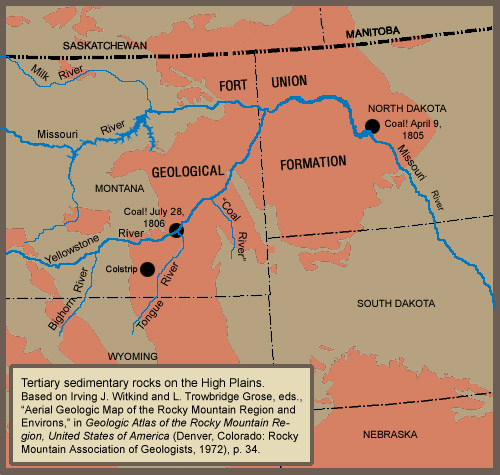Tertiary sedimentary rocks on the High Plains.[1]Based on Irving J. Witkind and L. Trowbridge Grose, eds., “Aerial Geologic Map of the Rocky Mountain Region and Environs,” in Geologic Atlas of the Rocky Mountain Region, United States of … Continue reading
Imagine an area about the size of Texas sprawled over parts of five states and two Canadian provinces. Today it is a high and dry plain, but sixty million years ago it was a shallow saucer in the earth’s crust, filled with warm, steamy tropical jungles. That rich, dense vegetation would, over some millions of orbits of Planet Earth around its sun, become a huge, complex deposit of lignite.
Along the western margin of this Texas-sized area was a range of low mountains where a half-dozen or so mighty rivers arose. Those rivers flowed eastward for more than 600 miles across a low, nearly featureless plain, then emptied into a vast inland sea.
Subtropical Climate
Although the sea was in the middle latitudes, centering about where Montana and North Dakota are today, the climate was subtropical[2]In a humid subtropical climate, as in southern Florida today, rain occurs year-round, usually delivered by large storms. On Earth today, this type of climate occurs in regions much farther south, … Continue reading with frequent, heavy rains. Those downpours regularly washed prodigious quantities of sediment from the western mountains into the rivers, making them run brown with sand, silt, and clay. As the rivers crossed the nearly flat eastern coast of the sea, their currents slowed and deposited most of the sediment they carried. The earth’s crust, adjusting itself to the weight of the load, sagged to become a huge, shallow basin, allowing for an even greater thickness of material to be deposited.
Between each pair of east-flowing rivers was a low divide occupied by extensive woodlands interspersed with open grasslands. The shapes of these forest-and-grassland mosaics shifted from age to age. Relatively few animals inhabited either the woodlands or the grasslands, and those that did were mostly small mammals. But fish and crustaceans thrived in the warm water. The vegetation grew luxuriantly the year around, especially in the swamps that bordered the rivers for many miles. As plants died, their remains slowly turn to peat. From time to time a sudden surge of floodwaters would cover the swamp, depositing layers of silt and sea-creatures’ skeletons on top of the peat.
Paleocene Epoch
Millions of years of geological history are recorded in the successive layers clearly seen in this cross-section of the Fort Union Formation. Neither Lewis nor Clark saw this particular scene, which was photographed about halfway between the Yellowstone and the Missouri rivers in eastern Montana, but they certainly saw many that were similar.
—Joseph Mussulman
It all happened again and again over a period of perhaps eleven million years, beginning about 65 million years ago, and ending about 54 million years back. We call that time the Paleocene Epoch.[3]Paleo is a Greek expression for “old”; cene means “new.” The Paleocene Epoch was the oldest of the five epochs that made up the Tertiary Period. Two more epochs, the … Continue reading The cycle of life and death, growth and decay, the rise and fall of the waters, the shifting of forest-and-grassland mosaics from age to age, and the ever-accumulating weight of it all, changed the silt into mudstone and the peat into coal, arranged in alternating layers.
We call this whole set of sea-born sedimentary rocks a formation; its various layers and puddles of mudstone, limestone, and coal are called members. After the inland sea dried up, rivers—mere trickles today compared with the torrents of the Paleocene Epoch—cut through the layered formation and exposed some of its members. Meriwether Lewis and William Clark were looking at cross-sections of this massive formation as they made their way up and down the Missouri and Yellowstone rivers in 1805 and 1806. The name “Fort Union Formation” was first used in a scientific publication by the renowned geologist, F.V. Hayden who, with F.B. Meek, had explored the formation as early as 1857.
Notes
| ↑1 | Based on Irving J. Witkind and L. Trowbridge Grose, eds., “Aerial Geologic Map of the Rocky Mountain Region and Environs,” in Geologic Atlas of the Rocky Mountain Region, United States of America (Denver, Colorado: Rocky Mountain Association of Geologists, 1972), 34. |
|---|---|
| ↑2 | In a humid subtropical climate, as in southern Florida today, rain occurs year-round, usually delivered by large storms. On Earth today, this type of climate occurs in regions much farther south, reaching only as far north as about 40 degrees from the equator. |
| ↑3 | Paleo is a Greek expression for “old”; cene means “new.” The Paleocene Epoch was the oldest of the five epochs that made up the Tertiary Period. Two more epochs, the Pleistocene and the Holocene, comprise the Quaternary Period, which brings us up to today. |
Experience the Lewis and Clark Trail
The Lewis and Clark Trail Experience—our sister site at lewisandclark.travel—connects the world to people and places on the Lewis and Clark Trail.
Discover More
- The Lewis and Clark Expedition: Day by Day by Gary E. Moulton (University of Nebraska Press, 2018). The story in prose, 14 May 1804–23 September 1806.
- The Lewis and Clark Journals: An American Epic of Discovery (abridged) by Gary E. Moulton (University of Nebraska Press, 2003). Selected journal excerpts, 14 May 1804–23 September 1806.
- The Lewis and Clark Journals. by Gary E. Moulton (University of Nebraska Press, 1983–2001). The complete story in 13 volumes.



